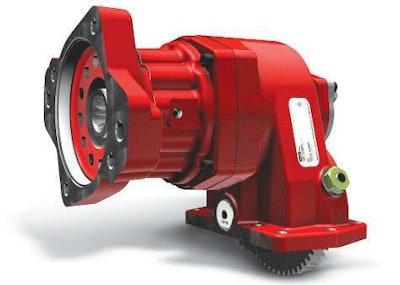
Used primarily to power an external powered attachment, a power take-off (PTO) is able to provide power anywhere under a truck and works through the drive line.
Although most PTOs are installed during original assembly, a PTO added in the aftermarket can be installed in 30 minutes or less.
But like most components, a PTO requires more than a quick installation to remain effective. Preventive maintenance and proper service also are keys to maximizing the effectiveness of an external PTO.
The first step in the acquisition of a PTO comes in the truck-buying process. Not every heavy-duty truck is built with a transmission that features a PTO accessible gear. Most are, but Parker Chelsea says it’s not entirely uncommon for a truck with an automatic transmission to not include PTO capabilities.
“It’s not always a standard option for a transmission,” the company says. “If you’re buying a truck with a manual transmission, it is going to come with the PTO drive. With an automatic, it’s not always standard to have one.”
However, some automatic transmissions come with a PTO option. And the addition of a PTO drive gear to an automatic transmission is costly — PTO installation is much cheaper and easier with a compatible transmission.
Though Muncie Power Products notes rear-mount PTOs are common in Europe and slowly growing in popularity in North America, most PTOs used in heavy-duty trucks are installed to power a hydraulic pump located under the truck’s main frame. The pump is used to disperse hydraulic fluid through the cylinder, and cool heated fluid that has circulated through the motor. In Class 8 trucks, the pump is activated by engaging the PTO when the transmission is in neutral.
Installing a PTO to power the pump takes time and skill. Before a PTO can be installed, a truck owner should answer some key questions about how the PTO will be used, says Muncie Power Products. These questions include identifying the vehicle make and model, direction of rotation of the PTO shaft, method by which the PTO is engaged, and more.
Once an ideal PTO is selected, the first step toward installation is draining the oil from the transmission and removing the PTO cover plate, experts say.
The PTO will be installed to the mating gear located below the plate. Once the plate has been removed, supplier experts say it’s important to remove all gasket debris where the PTO will be installed and check the location and quality of the gear inside the transmission.
Next, the technician should set the backlash units between the mating gear of the transmission and the PTO. Parker Chelsea recommends a backlash of 6,000 to 12,000 units for its PTOs.
“You can set the backlash by adding or subtracting gaskets,” the company says. “For us, we equate a 10,000 gasket as 6,000 backlash (units) plus or minus, and a 20,000 gasket is 12,000 (units) plus or minus.”
A loose PTO sounds like a jar of marbles, while a PTO installed too tightly will create a whining noise. Both situations can damage the mating gear and the PTO. Experts say a simple dial indicator used to measure the backlash when the PTO is installed can prevent both problems.
"If the noise caused by backlash cannot be totally alleviated by adding or removing gaskets, a chatter would be better than a whine, as a PTO mounted too tight can cause issues previously mentioned," adds Muncie Power Products.
After the backlash has been measured, it’s time to attach the PTO to the transmission housing. PTOs attach to different transmissions in different locations, but all PTOs need to be mounted directly onto the transmission frame to access the mating gear.
Muncie Power Products states a transmission’s PTO aperture may be of the six-bolt, eight-bolt or ten-bolt type, which refers to the number of fasteners used to attach the PTO to the transmission. Six- and eight-bolt openings are SAE standard sizes for manual and automatics, the company says, and the 10-bolt is exclusive to Allison automatic transmissions.
Once installed, the PTO is held in place by a fasteners connected to the transmission’s housing.
Depending on the PTO’s use, a drive line can be added to the completed PTO once installed to provide power anywhere under the truck. But the addition of a drive line means the addition of extra brackets under the truck to house the PTO, and added safety precautions to avoid PTO-related accidents.
Because of this, manufacturers note it’s become common to use the PTO to power a device close to or directly next to the PTO and transmission. As a matter of fact, that’s becoming the standard with hydraulic pumps.
“A lot of people are beginning to mount the pump directly to the PTO,” says one expert. “It eliminates that need for a drive line and allows you to install both at the same time.”
Parker Chelsea also recommends performing basic maintenance on the PTO once it’s been installed. He says greasing the PTO shaft before use is an excellent start, as is checking to make sure the PTO’s electronic controls function correctly from the cab.
The PTO can only be engaged by using controls inside the truck, so proper wiring and connectivity from the PTO to the cab is paramount.
After the PTO is operational, it’s important to set a maintenance schedule. Parker Chelsea provides service maintenance handbooks for its PTOs, and common checkups and diagnostic exams by qualified technicians eliminate a lot of potential problems.
If regularly serviced, a properly installed PTO should run for quite some time.
Parker Chelsea recommends customers who install a PTO tie the unit into the preventive maintenance schedule their corresponding transmission. “The two work together, you should think of them that way.”
For an Allison Transmission, preventive maintenance includes fluid and filter changes. The company says those changes aren’t affected by an attached PTO, and are recommended at 75,000 miles for the filter and 300,000 miles for the fluid.
Since Allison doesn’t provide PTO products, the company recommends following the PTO manufacturer’s service manual for additional maintenance requirements.
Additionally, experts say regular service inspections every three months and visual inspections should keep a PTO running; and it doesn’t take a genius to know what to look for when checking a PTO.
Notes Muncie Power Products, "A PTO is not like a windshield wiper or a mud flap; the right PTO must be configured for your specific truck and application. You need to find a supplier who will be your partner, and make sure the product they are selling will give you good, trouble-free service. A low price for the wrong PTO will not amount to any savings."
A tight or loose PTO has its own distinctive sound, and a PTO can leak just like any other part.
“People do inspections on their trucks every day when they look at the engine, the tires, the trailer, things like that,” says Parker Chelsea. “They look everywhere around the truck, so we just tell them to make sure they also look under the truck. You don’t have to crawl under it, but you can look to see how things are. It’s just like if you see an oil leak. If you look at the PTO and you think you see a problem, you can fix it before you get out on the road.
No one wants to break down when they’re out on the road. And with proper PTO service and installation, you don’t have to.










